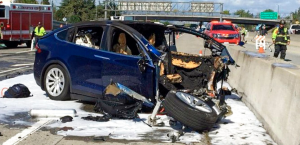The National Transportation Safety Board said Huang was on his phone playing a game while the vehicle’s autopilot system was engaged. The SUV swerved and hit a concrete barrier on the freeway in Mountain View, California.
The SUV also accelerated to 71 mph just before the crash. The car’s forward collision avoidance system didn’t alert Huang and the automatic emergency braking system didn’t engage, the National Transportation Safety Board found.

Photo: wsbtv.com
Despite the technology, the National Transportation Safety Board found Huang didn’t take control of the vehicle either by not steering or braking before impact.
The National Transportation Safety Board is not sure why the automation didn’t try to avoid the crash, looking at possible of faded lane lines and bright sunshine that affected the cameras, as well as closer-than-normal vehicle in the lane in front of the SUV.
The vehicle wasn’t the only thing found at fault. The cushion at the end of the barrier had not been fixed after a crash less than two weeks before.
The big takeaway National Transportation Safety Board issued though that a self-driving mode like Tesla’s Autopilot doesn’t mean that the car can fully be operated while the driver is doing other things.
“You can’t read a book, you can’t watch a movie or TV show, you can’t text and you can’t play video games,” National Transportation Safety Board Chairman Robert Sumwalt said.
What Is Distracted Driving?
Distracted driving is any activity that diverts attention from driving, including talking or texting on your phone, eating and drinking, talking to people in your vehicle, fiddling with the stereo, entertainment or navigation system—anything that takes your attention away from the task of safe driving.
Texting is the most alarming distraction. Sending or reading a text takes your eyes off the road for 5 seconds. At 55 mph, that’s like driving the length of an entire football field with your eyes closed.
You cannot drive safely unless the task of driving has your full attention. Any non-driving activity you engage in is a potential distraction and increases your risk of crashing.
Driving practices and rules that are taught in A-1’s Defensive Driving Class can be applied to be a safe driver. There is a lot of very useful and informative information in the class and it will apply whether you have been driving for years or you are a brand new driver.
For more information about class schedules or to see A-1’s 19 convenient locations call (770)962-9555 or visit us at www.a1drivingschools.com!
